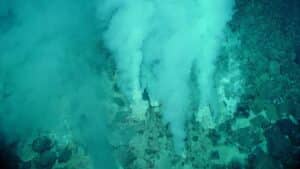The hadal zone, stretching between 6 and 11 kilometers beneath the ocean’s surface, has long remained one of Earth’s final frontiers. Marine biologists recently made a groundbreaking discovery in this mysterious realm—a new predatory species that has evolved remarkable hunting abilities despite its diminutive size. This finding not only expands our understanding of deep-sea ecosystems but also highlights how much remains unknown in the most extreme environments on our planet.
Remarkable predator discovered in ocean’s darkest depths
Scientists from the Woods Hole Oceanographic Institution (WHOI) and the Instituto Milenio de Oceanografía (IMO) in Chile have identified a fascinating new creature lurking in one of the most challenging environments on Earth. Named Dulcibella camanchaca, this predatory amphipod was found at approximately 8 kilometers below sea level in the Atacama Trench off the western coast of South America.
Despite measuring only 4 centimeters in length, this highly specialized deep-sea hunter possesses unique adaptations that make it a formidable predator in its habitat. Johanna Weston, co-director of the study from WHOI, explains, “The species exhibits impressive swimming capabilities, and we named it after the Andean word for ‘darkness,’ reflecting the gloomy environment where it actively hunts.”
Unlike many deep-sea creatures that passively wait for food to fall from above, Dulcibella camanchaca actively pursues other amphipods in total darkness. Its specialized appendages for grasping prey demonstrate how evolution has produced efficient predators even in the most extreme conditions.
| Characteristic | Description |
|---|---|
| Habitat | Atacama Trench (7,800m depth) |
| Size | Approximately 4cm |
| Classification | New genus and species of amphipod |
| Hunting style | Active predator with specialized grasping appendages |
For the First Time in 160,000 Years, This Rare Comet Will Be Visible Without a Telescope
A Secret Ocean 700km Underground? Scientists Confirm Stunning Discovery
New genus reveals unexpected biodiversity in extreme environments
The IDOOS 2023 Expedition (Integrated Deep-Ocean Observing System) captured four specimens of this novel creature, enabling researchers to conduct comprehensive morphological and genetic analyses. Their findings, published in the journal Systematics and Biodiversity, confirmed that Dulcibella camanchaca represents not just a new species but an entirely new genus—an extraordinary biological milestone.
In biological classification, discovering a new genus is particularly significant as it represents a previously unknown branch on the tree of life. Carolina González, co-director of the study at IMO, emphasizes that this discovery highlights the critical importance of continued exploration in the Atacama Trench, especially within Chilean territorial waters.
The taxonomic significance of this finding can be understood through these levels of classification:
- Species: Groups of organisms with common traits that can reproduce together
- Genus: Broader category grouping related species
- Family: Collection of related genera
- Order: Group of related families
- Class: Division containing related orders
A Combustion Engine That Pollutes Nothing: 440 Horsepower and Only Water as Output
Following Zuckerberg’s Lead, Sam Altman Proposes Apple Star–Inspired iPhone Replacement
Hidden wonders of the deep challenge scientific understanding
This discovery challenges the long-held assumption that hadal zones—the deepest ocean trenches—are biological deserts. Instead, these regions appear to host specialized ecosystems with unique food webs and predator-prey relationships that have evolved in isolation under extreme pressure conditions.
The finding of Dulcibella camanchaca demonstrates how deep-sea environments continue to surprise researchers with unexpected biodiversity. These ecosystems remain largely unexplored, with estimates suggesting that less than 5% of the deep ocean has been adequately studied.
As human activities increasingly impact the ocean through climate change, deep-sea mining, and pollution, understanding these remote ecosystems becomes ever more urgent. The creatures that inhabit the hadal zone may hold valuable insights into adaptation to extreme conditions and could potentially yield important discoveries in fields ranging from biomedicine to materials science.
With continued exploration using advanced technologies, scientists anticipate discovering many more remarkable species in Earth’s final frontier—the deep ocean trenches that have remained hidden from human eyes throughout most of history.







